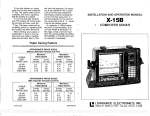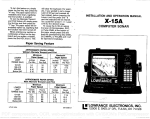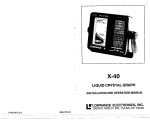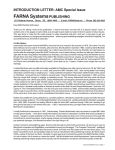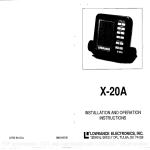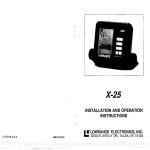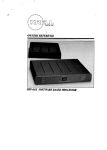Download Eagle Mach 1 Specifications
Transcript
the empty core onto the take-up shaft. (See Figure 23) Align the two notches in the core with the tabs on the lower take-up spool. • • Figure 18 Figure 19 — the stylus may be damaged. (See Figurel9.) SPECIALNOTE: The stylus may be damaged if the platen assembly is pulled down unless the stylus has been moved to the back side of the platen. 4. Pull out and down on the tab at the top center of the platen assembly to expose the paper spools. (See Figure2o.) 5. To remove the full take-uproll and the empty supply spool, press the two metal tabs togetheron the top of the platen assembly, and pull out and down on the paper retainer. (See Figure 21.) The full takeup roll can now be easilly removed from the paper core shafts. (See Figure 22.) 6. Pull the empty supply core from the right side in the same manner. Install F Notice—Use only genuine Eagle EGP-1 graph paper Substitute paper does not give satisfactory performance in Eagle graph recorders. 7. Slide a fresh roll of paper in position on the supplyside shaft on the right side of the platen assembly. The paper must spool off the bottom of the roll. (See Figure 24) 8. Draw the end of the paper across the face of the platen, around the friction roller, over thetake-upcore, and tape it squarely to the take-up core. (See Figure 25) Small pieces of tape may be stored inside the housing for this purpose. Close the top of the platen assembly by pressing the two tabs togetheron the paper retainer and returning the retainer back to the operating position. (See Figure26) 9. Turn the small knob at the upper left hand side of the platen assembly to put a small amount of tension on the paper. It should be snug against the platen.( Figure 27) 10. Push the platen assembly back to its operating position. Be sure it engages the catch inside the top of the case. (See Figure2O) 11. Closethe front of the case. Latch both catcheson the top of the case. 12. Turn the unit on. Movethe Chart Speed knobfully clockwise. Watch the paper long enough to be sure it is moving smoothly and evenly across the platen. If the paper flutters or begins to run "uphill", repeat step 8. Figure PDF compression, OCR, web-optimization with CVISION's PdfCompressor 21 11 STYLUS REPLACEMENT CAUTION — High voltage is pre- sent in the electronic section when the unit is turned on.' 1. TURN THE UNIT OFF. 2. Release both catcheson the top of the case. Pull out and down on the top of the case front to expose the stylus belt. (See Figurel8.) 3. The stylus belt rides over two Figure 17 wheels located at the right edge of the platen assembly. Move the front of the belt DOWNto position the stylus at the center of the platen. 4. Hold the stylus belt stationary with one finger, and remove the old stylus by starting at its left edge and moving it out from underthe tabs on the stylus holder. 5. Before installing the new stylus, be sure it is bent properly by camparing it to Figure 28. EAGLE is that it can record individual fish with a characteristic arched mark that separates them from their stationary surroundings. The reason for this is shown below. The distance to a fish when it moves into the sonar's cone of sound is shown as "A" in Figurel6. When the fish has moved to the centerof the cone, thedistanceto it will be shorter, (line "B"), and as it moves out of thecone, the distance will increase again as shown in line "C". If a partial arch occurs most of the time on your unit (the mark curves up, but does not curve back down or vice-versa), it is because the transducer is not aimed straight down. Sharp, well-defined signatures will occur most often when the Sensitivity knob is set at the ¾ point, or higher. (See "A", Figurel7). Remember, too, that there must be some movement between the fish and boat to develop the arched mark. 6. Refer to Figure29tobe sure the new stylus is positioned correctly under the tabs on the Figure 27 holder. Be sure it moves freely in the two slots. If not, bend the stylus away from the edge it is rubbing on until it does move freely. 7. After installing, if the stylus won't print all, the way down the paper as shown in Figure3O, bend the right leg down so that more pressure is exerted againstthe stainless steel plate. If it still does not print all the way, bend the left leg down more (but not so far that it digs into the paper). 8. Close the front of the case. Latch both catches on the top of the case. 12 of a warm and cool layer of water is called a thermocline. The depth and thicknessof the thermocline can vary with the season or time of day. In deep lakes there may be two or more, at different depths. Thermoclines are impor- tant to thefisherman because they are areas which fish are active. Manytimes baitfish will be above the thermocline while larger game fish suspend just below it. See "B", Figure 17. Your EAGLE Mach 1 can detect this invisiblelayer in the water, but the Sensitivity knob will probably have to be set at the 1/2 point, or higher. PAPER LOADING CAUTION — High voltage is present in the electronic section when the unit is turned on. 1. TURN THE UNIT OFF. 2. Release both catches on the top of the case. Pull out and down on the top of the case front to expose the platen as- Thermoclines sembly. (See Figurel8.) The temperature of water in the 3. Move the stylus belt DOWN, to positionthe marking stylus on the back side of the platen. NEVER move the belt up lake is seldom constant from top to bottom. Layers of different temperatures form, and the junction 9 PDF compression, OCR, web-optimization with CVISION's PdfCompressor . Figure 28 Figure 14 ZOoM "OFF" ZERO ADJUST Occasionally, when changing the stylus or stylus belt, the zero does not print at the same place near the top of the chart paper. By rotating the BOTTOM ZOOM control counter-clockwise the zero line can be moved towards the top of the chart paper, clockwise rotation moves the zero line towards the bottom of the paper. The control has been designed so that even if the record goes off the bottom of the paper, it- can still be adjusted to print on the paper. The ZEROADJUSTcontrol will function if the BOTTOM ZOOM feature is on or off. Figure 15 Figure 29 ZOOM"ON" MARKER Pressing the Marker button causesa verticalline to be printed on the paper. Hold the Marker button down and the unit will print the verticalline for as long as the button is held down. END OF PAPER MARKER The graph paper used in the MACH 1 has a red line printed at the bottom of the paper to signify when there is only 2 to 3 feet of paper remaining. IV HOW TO READ GRAPHS "Arched Signatures" A remarkable advantage of the STYLUS BELT REPLACEMENT CAUTION — High voltage is present in the electronic section when the unit is turned on, 1. TURN THE UNIT OFF. 2. Release both catcheson the top of the case. Pull out and down on the top of the case front and the platen to expose the stylus belt. Figure 16 3. The stylus belt rides over two wheels located at the right edge of the platen assembly. Refer to Figure 1 on page 2. Move the front of the belt DOWN to position .the stylus at the center of the platen. 4. Grasp the belt at the stylus holder with the thumb and forefinger and move it gently -I Figure 31 to the left while pushing the belt off the wheels with the other forefinger. (See Figure 31.) 5. Position the new belt on the 13 PDF compression, 8OCR, web-optimization with CVISION's PdfCompressor wheels by reversing the procedure used to removethe old one. BE SURE the fingers of the new stylus are pointed UP. 6. Close the front of the case. Latch both catches at the top of the unit. MAINTENANCE NOTE: The stylus may be damaged if it is in front of the platen when the platen assemblyis pulled down. Always move the stylus to the back side of the platen when changing the paper rolls. Remember to move the belt down to remove the stylus. Black carbon dust is created during the recording process. Use a soft, oil-free rag to clean the viewing door and metal platen behind the paper. Low pressure compressed air may be used to blow dust out of the case and away from moving parts if the air is dry and free of oil. After everyfive rolls of paper, the stylus belt and the wheels it rides on should be wiped clean with a soft, rag moistened with alcoholto remove carbon dust. Strong solvents or abrasive cleaners should not be used. All mechanical connections should be checked periodically to be sure they haven't worked loose. HIGH VOLTAGE is present in the transmitter sectionwhen the unit is ON. No attempt should be made by any unauthorized person to modify or repair the electronic section. All electrical connections should be checked periodically and cleaned as necessary. The face of the transducer, if mounted on the transomshould be washed periodically with mild soapy water to remove any accumulated rod grime or oily film. This is essential to have good contact between the transducer and the water. Periodically, the rubber roller on the paper drive should be cleaned with a cloth dampened with alcohol, to improvethe friction on the drive shaft. DO SECTION Do carry a spare fuse, stylUs belt, and roll of paper. Do use the empty cardboardcore from the last roll of paper on the take-up post. Do keep the recorded graphs for future reference. Do clean the stylus belt, wheels, and the rubber roller after every five rolls of paper. Q r p.r I Figure 11 GRAYLINE "OFF" per speed may also be slowed when not looking for fish or to simplyconserve paper. GRAYLINE CONTROL The GRAYLINE function can be used to outline the bottom contour which might otherwise be hidden beneath trees and brush; it can also give clues to the composition of the bottom. A hard bottom returns a very strong signal causing a wide gray line. A soft, muddy, or weedy bottom returns a weaker signal which is emphasized with a narrow gray line. Do not advance the control too far or it will gray line on the targetcompletely, showing no black, which makes the target difficult to see. RANGE This control determines the depth scale displayed on the chart paper. (See Figure 13) BOTtOM ZOOM By pulling out the knob, the feature allows you to "Zoom in" on the lower half of the range being displayed on the graph. In other words, with the Range control set to the 60 foot range, and the Bottom Zoom control pushed in (OFF), the scale printed on the chart paperwill be 0 to 60 feet. (See Figure 14.) With the Bottom Zoom control pulled out (ON), the scale will be 30 to 60 feet. This allows you to double the size of anytarget or feature in the lower half of any depth range. (Figure 15.) DON'T SECTION DON'T OPEN THE CASE WHEN THE UNIT IS ON. Don't pull the platen assembly ZERO ADJUST There are 12 ranges: down when the stylus is at the front. Don't store any objectsinside the case or behind the viewing window. (Except for small pieces of tape.) Don't forget to tape the paperto 14 GRAYLINE "ON" Figure 12 Figure 13 @ERANGE 0-10 feet 0-20 0-40 0-60 0-80 0-100 0-140 0-200 0-300 0-400 0-600 0-1000 IOU —p -. . 140 60 60 —.... 40 ---e —2O0 — r—60O 20 10 &___300 —1000 r GRAYLINER '<_PAPER SPEED 0 7 4 4 PDF compression, OCR, web-optimization with CVISION's PdfCompressor sound pulse hasto travel, the weaker it becomes. By broadening the pulsewidth, in essence, a larger signal is transmitted and it is easier for the receiver to detect it. For this reason, the micro-computer in the MACH 1 automatically increases the initial pulse width of the unit as deeper ranges are selected by the operator. NOTE: Initial pulse width is the pulse width of the unit when the Suppressor control is turned to minimum. RANGE (feet) INITIAL TRANSMIT PULSE WIDTH (micro-seconds) 20 10 110 150 300 400 600-1000 200 300 400 600 40-200 The transmitter pulse width can be increased from the initial point at any time by rotating the Suppressor control clockwise. The maximum amount of pulse width the range control is set to 300 feet, and the Suppressor control is rotated to the maximum clockwise position, thetransmitter pulse width would be 1100 microseconds. (300 initial pIus 800 equals 1100 micro-seconds.) Paper Speed Control This knob adjuststhe speed of thechart paper. For good detailed graphs,in shallowto medium depths, turn the paper speed control up to at least ¾ when trolling. For best details,turn it up to maximum. This will show proper fish arches at low speeds and keeps high speed information from being compressed. The paper speed should be turned down when using the unit in deep water. This will prevent gaps from appearing in the record. In fact, the microcomputer will automatically slow the maximum speed of the chart paper when operating in deep water. The chart below gives the points where the maximum speed of the paper is slowed. The chart paper may be slowed even further by adjusting the paper speed control. Remember, if APPROXIMATE PAPER SPEED Minimum Paper Speed RANGE (feet) 10-100 140-200 300-600 1000 Inches Per Mm Hours Per Roll 1.0 0.5 10 0.2 0.2 20 50 50 the take-upcore. Don't rotatethe stylus belt up. Don't use oily cloths, strong solvents, or abrasive cleansers. TROUBLESHOOTING SECTION Symptom On/Off switch is "ON", but the stylus and paperdon't move. What To Do Check fuse; check connections at battery for tightness and corrosion. Symptom On/Off switch is "ON", have zero mark, but no echoes or bottom signal. What To Do Be sure the transducer is plugged into the unit and the transducer is in contactwith the water. Symptom The unit is "ON", but paper does not move. What To Do Tape paperto cardboard spool on take-uppost. Symptom Recordermarks are faint or dim. What To Do Cleanviewing door; replace the stylus; check battery connections. Symptom Recorded marks are very heavy; paper is torn by stylus. What To Do Bend the stylusslightly to reduce pressure on paper. VI ADVANCED OPERATION The EAGLE MACH 1 takes advantage of the micro-processor's power, giving you optionsthat allows it to outperform the vast majority of graph recorders in the sportfishing field. To use the functions in this sectiontwo controls must be used simultaneously. We urge you to read this section carefullyto take advantage of the superiorperformance of the EAGLEMACNi. Lines When the unit is first turned on, depth lines are printed automatically on the paper. If you desire to turn the lines off, rotate the range control to 20 feet, holdthe marker switch 'ON", and rotate the range control to the 10 feet position. The marker switch must be "ON" during the switch from 20 to 10 feet. The MACH 1 will stop printing the Maximum Paper Speed Inches Hours Per Mm Per Roil — 3.0 2.0 1.2 3.3 0.75 13.3 5.0 8.3 2H 2H H 2H 3b BE b Sb— LI9 L9 L19 bE ED ----——--—-——---— ERDLE Figure 10 added to theinitial transmitter pulse width is approximately 800 micro-seconds. In other words, if gaps appear in the record, turn the paper speed down until a solid record is achieved. The pa- ED ER6LE ED - Figure 32 LINES"OFF" Figure 33 LINES "ON" 15 PDF compression,6OCR, web-optimization with CVISION's PdfCompressor lines immediately. Turn the range control back to your original depth setting. To turn the lines back on, simply reverse the procedure by turning the range control to 10 feet, hold the marker switch "ON", and rotate the rnge control to the 20 feet position. Lines will be printed on the paper. Return the range control to the desired depth setting. Transmitand Print Alternate When using the MACH 1 in deep water, it may be desirable to slow the papersped down considerably. However, when doing so, you may get 'over print" or very dark, heavy printing over an area that is difficult to read. Much detail can be lost due to this. An available feature is the Transmit and Print Alternate function which, when activated, triggers the transmitter and causesthe stylusto print every other revolution instead of every revolution. This accomplishes three things: 1. Since the stylus only prints every other revolution, the recorded information is not squeezed together into a very small area. This allows better records at slower paper speeds. Also, the scale numbers are spread out more, so they are more legible. 2. Prevents the possibility of "wrap around". This is the undesirable occurrence of the second or third bottom echo printed on the paper at the top or middle of the page. Many timesthis can interfere with fish or othertargets that you Scale The numbers that indicate the depth or scale may be deleted if desired. Rotate the range control to the 60 feet position, hold the marker control "ON", and turn the range control to the 40 feet position. The depth scale will no longer be printed. The range control now may be turned to the desired depth setting. To turn the depth scale back on, rotate the range control to 40 feet, hold the marker switch "ON", and rotate the range control back to the 60 feet position. Remember, the marker switch must be on during the period of time that the range control is switched. Return the range control to the desired depth setting. 24 3b -———- - -- -— by ——— - Figure 34 cavitation noise. In both cases, the noise could produceunwanted marks on the paper. (See Figure 7). Fortunately, noise — -- —r —________ HO —— P ability to separate fish from the bottom or from other fish will be decreased. (See Figure 9). Therefore, the lowerthe suppression setting, the better. Advance the knob setting only as far as necessary to remove the erratic, unwanted noise marks. Most of the time at low or trolling speeds, no suppression will be needed. However, it is helpful sometimes to have longer pulse widths when noise is not a concern. When us- - :..çj—TT1: - --—Iff...!J'1!Ijii — .-1 EQ ---——---————-EHIL Figure 6 pulses are relatively short in time compared to real sonar signals. Advancing the Suppressor knob will cause the systemto reject these unwanted, short pulses Figure 7 ing a sonar in deeperwater, it is easier-for the unit to detect a longer pulse coming back from the bottom or from the fish. This is called "Probability of Echo Detec- withoutreducingthe sensitivityin any way. However, with high suppression settings,the graph record becomes coarse and the tion". The probability of the unit being able to detect an echo returning from deep water is diminished because the furtherthe PROPER SEllING SUPPRESSION: TOO HIGH Figure 8 Figure 9 --—--———- — — ________- Lb 4 —--- HR wish to see. Suppressor Control The Suppressor Control is used to reduce interference from noise. Noise, in electronic terms, is any undesired signal. It can be caused by an electrical source, (such as the engine's ignition system), or by air bubbles in disturbed water which is called ERELE — -- bu-- EAGLE SCALE "ON" 16 Figure 35 SCALE "OFF" PDF compression, OCR, web-optimization with CVISION's PdfCompressor Figure 3 BASIC OPERATION ON-OFF and SENSITIVITY Control Rotate the ON/OFF knob clockwise to turn the unit on. The Sensitivity knob works much like the volume control on a radio, that is, weaker signals will be detected with highersettingsof the knob. When cruising, or at other times when justsimple bottom-contour information is desired, the Sensitivity setting can be low. In deep water or over soft, muddy bottoms which produce weak echoes, the setting will haveto be higher. When high Sensitivitysettings are used, a second bottom echowill appear. This is normal and is caused by the returning signal reflectingoff the surface of the water, making a second trip to the bottom and back. When detailed information about brush piles, individual fish or the thermoclineis desired, the Sensitivity knob should be set approximately to the ¾ point. Refer to the illustration belowto see what effect the Sensitivity setting has on the recorded information. Recording individual fish with an "arched" signaturecan usually be accomplished at trolling speeds with the Sensitivityknob at the ¾ point, or higher. Referto the section "ArchedSignatures" for more information about this important function of your recorder. 3. Reduces the reverberation effect. This happens mainly on lower frequency units, although it does sometimes show up on high frequency graphs. To use the Transmit and Print Alternatefunction, turn the range control to 100 feet. Next, hold down the marker switch and turn the range control to 80 feet. Now release the marker switch. Return the range control to your original setting. The MACH 1 will now be in the Transmit and Print Alternatemode. Remember, the marker control must be "ON" dur- ing the period of time that the range control is turned from 100 to 80 feet. To return the MACH 1 to normal operation, simply reverse the operation by turning the range control to 80 feet, hold the marker switch "ON", rotate the range control to100 feet, and release the marker switch. NOTE: A simpleway to return any of the optional featuresback to normal operation is to turn the sensitivity control to the "OFF" position and then turn it back "ON". This turns off the power to the unit, erasing all of the op- APPROXIMATE PAPER SPEED Minimum Paper Speed RANGE(feet) Inches Per Mm Hours Per Roll 10-100 0.6 17 140-200 300-600 1000 Figure 36 0.4 Maximum Paper Speed Inches Hours Per Mm Per Roll 2.0 5.0 1.2 8.3 0.75 13.3 25 0.2 50 02 50 015 (with Alternate Transmit and Print) 1 13.3 By comparing this chart with the one on page 6, you can see that a significant amount of paper can be saved by using the AlternateTransmit and Print function. n 2 2L1 SENSITIVITY: PROPER SETTING SENSITIVITY: TOO LOW Figure 4 Figure 5 Figure 37 PDF compression, 4OCR, web-optimization with CVISION's PdfCompressor 17 tional featuresthat you have programmedin. Just remember, if you have turned the lines and the scales off, and you wish to turn only the scales back on, don't turn off power to the unit or you will have both lines and scales on — Figure 38 when you turn the unit back on. Turning the unit off and then on again only works as a quick method when you only have one feature on, or all of the optional features that you wish to return to normal. bfl—--2-- RANGE: 60 FEET ZOOM: OFF SENSITIVITY: 1/2 SUPPRESSOR: MINIMUM PAPER SPEED: 3/4 GRAYLINE: MINIMUM Figure 39 RANGE: 30 FEET SUPPRESSOR: MINIMUM SENSITIVITY: 3/4 p I I RANGE: 60 FEET ZOOM: ON SENSITIVITY: 1/2 SUPPRESSOR: MINIMUM PAPER SPEED: 3/4 GRAYLINE: MINIMUM described in Section VI — Advanced Operation. This chapter will explain the other features that will enable the serious operator to getthe maximum use out of your EAGLE. We urge you to read this manual thoroughly and familiarizeyourself with the controls. Although this is a very advanced unit, it is easy to use, thanks to the power of the microcomputer and the front panel controls. Should you require extra help, please phone our Customer Service Department toll free — 1-800-331-2301. Oklahoma residents call collect 918-266-5373. A service representative will be happy to help you. INSTALLATION Mounting — The depth soundermay be installed in any convenient area, provided the unit can be tilted for the best viewing angle. Holes in the bracket allow wood screw or thru bolt mounting. A wood stiffener may be required on the back of thin fiberglasspanelsto support the unit. If the desired location is closer than 18" to a magnetic compass, a trial run should be made with the unit in operation to be sure that the compass readings are POWER CONNECTIONS 12 volt DC power for the sonar unit should be supplied from the boat's 12 volt DC electrical system. The power cable may be attached to an accessoryor power buss, but if you have problems with electrical interference, the cable should be attacheddirectly to the battery. If a longer cable is required, use ordinary #18 lamp cord available at any hardware or electronic supply store. Splices should be soldered. If this can't be done, use crimp type splices. Tape all connections with electrical tape. An in-line fuse holder with fuse is supplied with the EAGLE graph. Be certain to install this fuse holder as close to the power source as possible. This will protect both the sonar unit and the power cable in the event a short occurs. Crimp connectorsare supplied to attach the fuse holder to the powercable. The red wire in the power cable is the positive conductor. The black wire is the ground or negative conductor. The graph is protected from accidental polarity reversals and no damage will occur if the wires are reversed. However, the unit will not operate until the proper polarity is applied. Ground (Negative) LINES:OFF PAPER SPEED: 3/4 ZOOM: ON GRAYLINE: MINIMUM not affected. Figure 2 3 PDF compression, 18OCR, web-optimization with CVISION's PdfCompressor echo can be read in feet by comparing its location on the paper to the depth scale printed on the 1. INTRODUCTION Small boat sonar systems are routinely used to measure water depth, examine bottom contours, and locatefish. The Eagle MACH 1 recordergoes far beyond the ordinary in displaying these objects, plus many more such as schools of baitfish, algae and plankton, thermoclines, individual fish closer than six inches apart, and much more. These features combine to make the MACH 1 a superiorgraph recorderfor today's sportfishing - paper. A constant speed motor drives the papergraph. (The paper is treated so that the stylus will burn it to leave a permanent black 1::: a mark.) During one revolution of the stylus belt, a very narrow mark will be made by the flexible stylus, but the paper will move a small amount before the next revolution. Each mark will blend into the one before, so that a composite 'picture" of the target will be industry. made, one tiny mark at a time. Due to the many featuresthat 2. HOW IT WORKS this unit has, we have split the When the unit is turned on, an operation section of this manual into two sections. The first part, electronically regulated motor drives a lightweight belt located Section III, is entitled "Basic Opat the right edge of the rqcording eration" and covers everything that is absolutely necessary to paper. The marking stylus is attached to the belt. When the styuse your EAGLE in a wide variety lus is at the top of the paper a of situations. It will tell you how to small mark is made. This is called use the basic controls — Senthe zero mark, and represents the sitivity, Suppressor, Paper Speed, surface of the water. The stylus GRAYLINE, Range, Marker, plus continues to move down the edge a few special functions. This secof the paperwhile the sound tion will be adequate for most pulse is traveling through the wa- situations. However, once you ter, and when an echo is dehave mastered the basic operatected, the stylus makes another tion of the EAGLE MACH 1, as mark on the paper. The depth of described in Section Ill, you may the object which reflected the wish to try some of the features Figure 40 RANGE: 60 FEET ZOOM: OFF SUPPRESSOR: MINIMUM SENSITIVITY: 314 PAPER SPEED: 3/4 GRAYLINE: MINIMUM. LINES:ON Mi 2 p 2H -. A3 -' HO tA r 1, Figure 41 RANGE:60 FEET ZOOM:OFF SENSITIVITY: 3/4 SUPPRESSOR: MINIMUM LINES: OFF PAPER SPEED: MAXIMUM GRAYLINE: MINIMUM Figure 42 RANGE: 80 FEET SENSITIVITY: MAXIMUM SUPPRESSOR: MINIMUM ZOOM: OFF PULLEY DRIVE STYLUS DRIVE BELT STYLUS PULLEY Figure PAPER SPEED: MAXIMUM LINES: OFF GRAYLINE: MINIMUM 19 PDF compression, OCR, web-optimization with CVISION's PdfCompressor 2 INDEX I? - LJLI & !t&!i L.± P A - ic Introduction How It Works PAPER SPEED: MAXIMUM GRAYLINE® 2 3 4 5 6 7 ZOOM: OFF GRAYLINE: MINIMUM Bottom Zoom 7 Range Marker 7 End Of Paper How To Read Graphs 8 Installation Basic Operation Suppressor Paper Speed Figure 43 RANGE: 60 FEET SENSITIVITY: 3/4 SUPPRESSOR: MINIMUM LINES:OFF Paper Loading SPECIFICATIONS Operating Frequency . . 192 kHZ (192,000 cycles per second); accuracy is within 0.6 percent. 110-1400 us (ADJUSTABLE) Pulse Width (Duration of Pulse) Operating Voltage Operating Current Output Power Weight Dimensions 2 Minimum: 10 volts D.C. Maximum: 15 volts D.C. 0.7 to 1.8 amps depending on printing 8 8 9 Stylus Replacement Stylus Belt Replacement 12 Do's and Dont's 14 Troubleshooting Advanced Operation 15 Scale 16 Specifications Service Information 20 12 15 20 densityand output power. 1600 watts typical peakto peak. (200 watts RMS) 7 lbs. 14 oz Width-i21/it, Height-9", Depth-65/s" NOTICE Periodically wash the Transducer Face with soap and water to remove any oil film that may collect. Oil and dirt on the face will reduce sensitivity or may even prevent sounding. 20 NOTE: This sonar uses LPG -605 Chart Paper. PDF compression, OCR, web-optimization with CVISION's PdfCompressor HOW TO OBTAIN SERVICE Eagle Electronicswill provide quickand efficient servicewith genuine Eagle parts should you ever require it. Ifyou do require service,call or write us at the address belowbeforesending intheunit. We maybe able to save you the inconvenienceofsending the unitbackfor repairs. Ifyou do have to returnthe unitfor service,please enclosea letter statingthe problemthat you are having with the unit. This will assist us in the testing and repair ofyour depth sounder. Mail to: EAGLE ELECTRONICS P.O. BOX 669 CATOOSA, OKLAHOMA 74015 If you live out of the state of Oklahoma, call 1-800-331-2301. If you live in the state of Oklahoma, call collect 918-266-5373. SCHEMATIC DIAGRAM& PARTS LIST Should you desire a schematic and parts list for your EAGLE depth sounder,send $1.00 to the address above and it will be mailed to you promptly. Please be sureandgive us themodelandserialnumber ofyour EAGLE. @ Copyright 1963 Lowrance Electronics, Inc. PDF compression, OCR, web-optimization with CVISION's PdfCompressor EAGLE AND OPERATION MANUAL INSTALLATION JJLJ flT jjJ GRAPH RECORDER dAn I flA • fi / MADAINUS A EAGLE ELECTRONICS LIThO USA P0. BOX 669, CATOOSA, OKLA. 74015 988-0095-01 Divsion at U ALawrence Electronics. Inc PDF compression, OCR, web-optimization with CVISION's PdfCompressor













